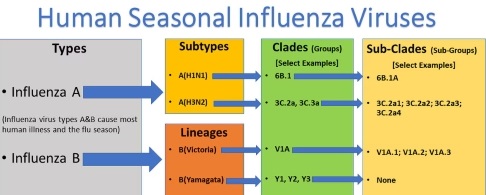Influenza, commonly known as the flu, is a contagious respiratory illness caused by influenza viruses. It can range from mild to severe and, in some cases, lead to complications such as pneumonia, bronchitis, or worsening of chronic conditions like asthma or heart disease. The flu spreads through respiratory droplets when an infected person coughs, sneezes, or talks. Understanding its causes, symptoms, prevention, and treatment is essential for public health awareness.

Source: cdc.gov
Current Flu Season Trends
- The U.S. is experiencing a surge in flu cases, straining hospitals.
- According to the Centers for Disease Control and Prevention (CDC), most cases this season are caused by Influenza A (H1N1 and H3N2 variants).
- Flu activity remains high to very high across many states
- Influenza A: More common at the beginning of the flu season (October–January).
- Influenza B: More prevalent towards the end of the season (February–April).
- Flu seasons vary each year, and both strains can circulate simultaneously.
Causes of Flu
The flu is caused by influenza viruses, primarily categorized into four types:
- Influenza A: The most common type, known for causing seasonal flu epidemics and pandemics.
- Influenza B: Circulates annually and is generally less severe than Influenza A.
- Influenza C: Causes mild respiratory infections and does not lead to epidemics.
- Influenza D: Affects cattle and is not known to infect humans.
What are the differences between Influenza A & Influenza B?

Source: cdc.gov
Differences between Influenza A & Influenza B is :
| Feature | Influenza A | Influenza B |
| Virus Type | Belongs to the Orthomyxoviridae family; has multiple subtypes classified based on hemagglutinin (H) and neuraminidase (N) proteins (e.g., H1N1, H3N2). | Also belongs to Orthomyxoviridae but has no subtypes; instead, it has two main lineages: Victoria and Yamagata. |
| Severity | More severe due to rapid mutations and the potential for pandemics. Can cause intense flu seasons with high hospitalization and mortality rates. | Generally milder than Influenza A but can still cause severe illness, especially in high-risk individuals. |
| Mutation Rate | High mutation rate due to both antigenic shift (major genetic changes, leading to new subtypes) and antigenic drift (gradual mutations). | Lower mutation rate; undergoes only antigenic drift, meaning the virus changes slowly over time. |
| Pandemic Potential | Capable of causing global pandemics due to antigenic shift, as seen in the 1918 Spanish Flu and 2009 H1N1 outbreak. | Does not cause pandemics, as it only circulates among humans and lacks major genetic shifts. |
| Transmission | Spread through respiratory droplets, contaminated surfaces, and close human contact. Zoonotic transmission (animal-to-human) is possible. | A similar transmission method as Influenza A but is limited to human-to-human transmission. |
| Affected Age Groups | Affects all age groups but is more dangerous for infants, the elderly, pregnant women, and immunocompromised individuals. | Mostly affects children and the elderly but generally causes less severe illness. |
| Animal Reservoir | Yes – found in birds, pigs, horses, and other animals, which increases the risk of zoonotic transmission and new strains emerging. | No – primarily infects humans; no known animal reservoir, reducing chances of new strains emerging from animals. |
| Seasonality | More common and peaks during flu season (fall & winter). Can circulate year-round in some regions. | Occurs seasonally but is less frequent compared to Influenza A. |
What are the Symptoms of Flu?
Flu symptoms typically appear suddenly and can include:
- High fever or chills
- Persistent cough
- Sore throat
- Runny or stuffy nose
- Muscle or body aches
- Fatigue and weakness
- Headaches
- Vomiting or diarrhea (more common in children than adults)
Conclusion
Understanding the differences between Influenza A and Influenza B helps in better management and prevention. While Influenza A is more aggressive and has pandemic potential, Influenza B can still cause significant illness. Vaccination, hygiene, and early detection remain the best defenses against both strains.
Comments
All Comments (0)
Join the conversation